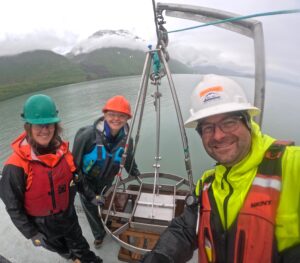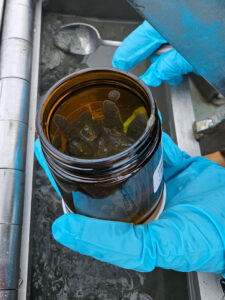Further study needed to determine source and potential effects

A new Council study has confirmed that sediments in Port Valdez contain traces of metals at concentrations that could negatively affect the organisms that live at the sea floor.
This pilot study was conducted in 2024, during the routine environmental monitoring conducted by the Council since 1993. The work was prompted by a previous analysis that showed the presence of metals in the water discharged from the Valdez Marine Terminal’s ballast water treatment facility.
Council staff and Dr. Morgan Bender from Fjord & Fish Sciences collected samples of sediments from two locations in Port Valdez: one near the terminal, and a reference site near Gold Creek. The site near the terminal was chosen to confirm whether the metals found in the previous study were accumulating in nearby sediments. Gold Creek was sampled for comparison.
Dr. Bender compared the results to sediment quality guidelines developed by the National Oceanic and Atmospheric Administration, or NOAA. These guidelines are used to determine whether toxins in sediment are concentrated enough to harm organisms.
Both sites show increased concentrations of metals

The study found a total of 22 metals between the two sites, in varying concentrations.
Both sites exceeded NOAA’s sediment quality guidelines for eight of the metals: iron, vanadium, aluminum, arsenic, nickel, cobalt, copper, and selenium.
“Terminal sediments had significantly higher metal concentrations overall,” when compared to Gold Creek, states the report, including four metals that were previously found in water discharges from the treatment facility: iron, aluminum, copper, and vanadium. However, all these metals also exceeded the threshold for effect at Gold Creek.
The report noted that “there is a potential ecological risk” from the discharge of these metals.
Local conditions may contribute to high metal concentrations
“Port Valdez is a metal-rich system with a history of copper and gold mining and several large, glacially-fed rivers entering within miles of the sampling locations,” Dr. Bender noted in the report. “These local sources may explain regional patterns such as high iron concentration.”
Dr. Bender noted that while some metals could be tied to the discharge from the terminal, further study is needed to determine the actual source of the metals.
Why are metals of concern?
Metals such as those found in this study are generally stable and do not degrade. Accumulated metals at toxic levels can have a variety of adverse effects, including organ damage, cancer, and damage to DNA. They can enter the food chain when ingested by the tiny organisms that live in the sediment.
Read the report: 2024 Sediment Metals Report
The study was prompted by a previous analysis investigating traces of hydrocarbons and metals in the effluent from the Valdez Marine Terminal’s ballast water treatment facility. Metals were present in that analysis: Examining the Effectiveness of Ballast Water Treatment Processes